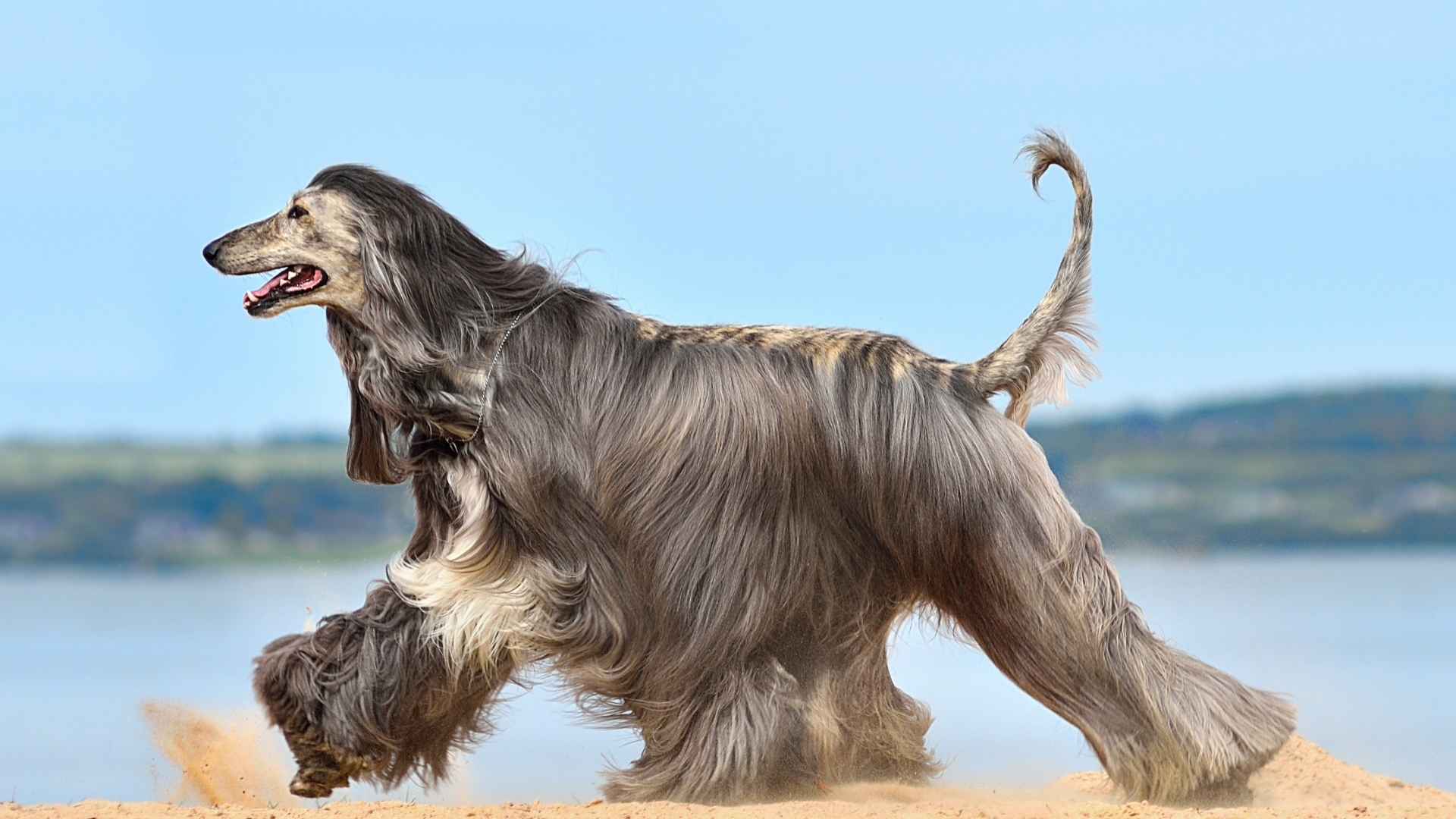If you’re a dog lover who’s captivated by stunning, luxurious fur, then extra-long coat dog breeds might just be the perfect fit for you. With their gorgeously silky coats, these breeds often steal the spotlight with their eye-catching appearance and fluffy charm. From long-haired dog breeds that demand regular grooming to fluffy dogs with thick double coats, their coats can vary in texture, color, and style, making them an absolute joy to look after.
Whether you’re fascinated by a silky flowing coat or a shaggy coat, these dogs bring a unique flair to your home. Caring for such coats requires dedication, but the reward is a beautiful companion with an unmistakable presence.
In this article, we dive into some of the longest-haired breeds, their grooming needs, and why they’re adored by so many dog enthusiasts.
Extra Long Coat Dog Breeds
1. Afghan Hound
With its flowing, silky coat and aristocratic posture, the Afghan Hound is truly a showstopper. Originally bred in the rugged terrains of Afghanistan, this breed was designed to hunt game across mountainous regions. Its thick, luxurious coat protected it from harsh weather, while its lean body and powerful legs made it an expert chaser.
The Afghan Hound’s coat is one of its most striking features, but it comes with a high-maintenance tag. Grooming is a serious commitment with this breed. Frequent brushing several times a week is essential to avoid tangles and mats, and regular baths help keep the coat healthy, silky, and shiny. Owners often describe grooming as a bonding ritual with this elegant companion. The long, flowing fur can easily tangle, so regular brushing using a pin brush or undercoat rake is essential to prevent loose hairs and tangles.
The Afghan Hound is often the only dog in the household due to its independent nature and strong personality, requiring a devoted owner to meet its unique needs. This breed can be shy around strangers, which only adds to its mystique. Whether it’s its gorgeously silky coat or its charming nature, the Afghan Hound’s presence is captivating.
Exercise is important for these pups, not just to burn off energy but to keep them mentally sharp. Long walks, safe open spaces to run, and interactive games help this breed stay happy. However, training requires patience because Afghan Hounds like to do things their own way. Their long double coat is also susceptible to dirt and debris, which means frequent brushing is key for maintaining their coat.
2. Briard
The Briard is a big-hearted dog wrapped in a huge, shaggy coat. This French herding breed has been around for centuries, originally used to guard and herd sheep. Today, it’s known just as much for its loyalty and courage as for its bushy eyebrows and flowing locks. The double coat of the Briard offers excellent protection from the elements, making this breed particularly well-suited for outdoor work.
The Briard’s coat is dense and slightly wavy, requiring consistent grooming to maintain its natural beauty. Weekly brushing is necessary to prevent the coat from matting and ensure that it remains tangle-free. The Briard’s undercoat can trap loose hairs, so it’s crucial to use a pin brush and undercoat rake to remove these and keep the coat healthy. The soft undercoat is an essential part of their thick coat, providing insulation from both cold and harsh weather.
This breed’s appearance isn’t the only thing that sets it apart—it’s the personality packed underneath that truly makes the Briard a standout. Briards are intelligent, affectionate, and fiercely protective. They make great family pets and are especially good with children. As herding dogs, they thrive in active households and enjoy taking on tasks that challenge their minds.
Because Briards were bred for work, they need physical and mental challenges. Long walks, obedience training, and puzzle toys help channel their energy in a positive direction. They don’t just want to be around people—they want a job to do, and their dense double coat requires regular grooming to keep it from becoming tangled during their activities.
The Briard’s appearance is unique, but so is its spirit. This is a dog for someone who wants a loyal friend with a dash of drama in the grooming department and a ton of personality to match.
3. Lhasa Apso
Small, sturdy, and draped in a long, dense coat, the Lhasa Apso is a breed with ancient Tibetan roots. Once kept as sentinel dogs in monasteries, these little charmers were trusted to sound the alarm when intruders came too close. Today, they’re better known for their good looks and strong-willed attitude. The Lhasa Apso’s long coat reaches the floor if left untrimmed and requires consistent care.
The Lhasa Apso’s coat is heavy and straight, offering ample protection from the cold mountain climate of Tibet. This breed requires daily brushing to prevent mats and tangles, and some owners opt to trim the coat to keep it manageable. With regular grooming, the coat remains silky and luxurious, showcasing the breed’s aristocratic roots. Their dense undercoat, combined with the long fur, provides protection from both the cold and harsh elements.
Don’t be fooled by their size—Lhasas have big personalities. They’re confident, sometimes aloof, and often act like royalty. That said, they’re also loving and loyal once they bond with their humans. Their furry coat and luxurious fur can make them prone to mats if not properly maintained, so frequent brushing is a must to keep the coat tangle-free and shiny.
Training a Lhasa Apso takes patience and consistency. They’re smart but independent thinkers, so early socialization and firm leadership are key. With regular brushing and grooming, their beautiful coat remains manageable, and their charming personality shines through. They enjoy attention and make excellent companions for those willing to invest time in maintaining their gorgeous coat.
4. Pekingese
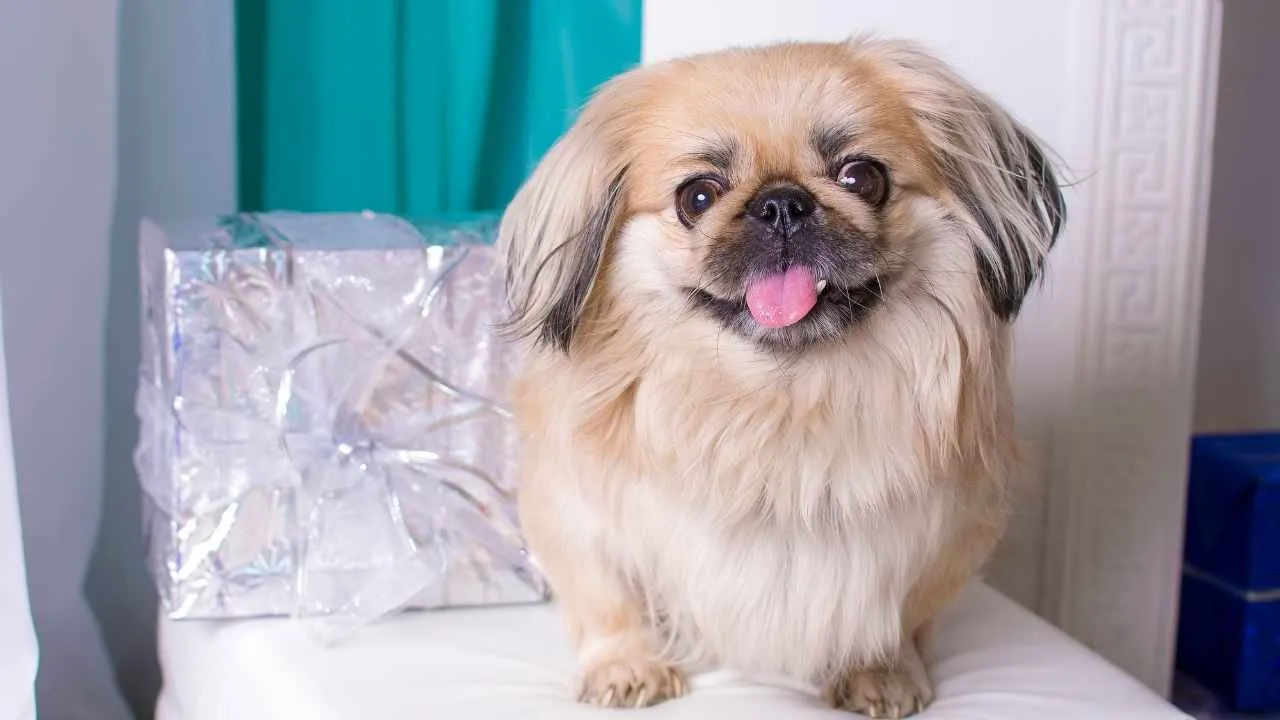
Regal, proud, and full of character, the Pekingese has a look and attitude straight out of an imperial palace. And that’s no accident. These dogs were favored by Chinese emperors and even had their own servants. Their thick, straight coat and confident walk are testaments to their noble history. The Pekingese’s long coat often requires professional grooming to maintain its appearance.
The Pekingese’s coat is thick and long, and like other long-haired dog breeds, it requires consistent care. Frequent brushing is a must to avoid mats, especially around the neck where the coat forms a mane-like ruff. Many owners choose to trim the coat to keep it neat, but even with trimming, daily brushing is advised to keep their silky fur healthy and tangle-free. Regular brushing also helps remove loose hairs, which can easily accumulate in their coat.
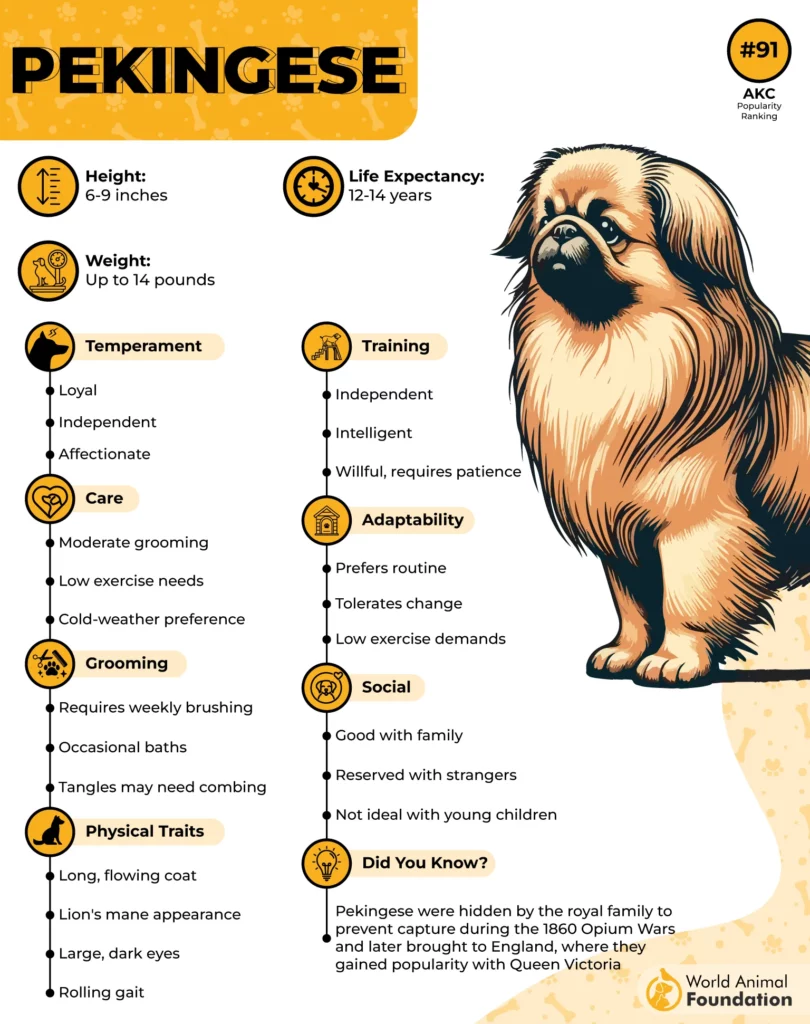
Though they look like lap dogs, Pekingese have an independent streak. They’re not clingy, but they do enjoy companionship and love to sit beside their favorite person. Their thick, dense coat requires extra attention to prevent tangles and to maintain the healthy condition of their fur. The Pekingese’s coat is a significant part of its charm, so regular grooming with a pin brush and undercoat rake is essential.
These pups don’t need intense exercise, but they do enjoy daily strolls and playtime. Because of their flat faces, it’s important to avoid overheating, especially in hot weather. The coat may require additional care in warmer climates, but their luxurious fur makes them stand out in any setting. Their glamorous breed status adds to their appeal as low-energy dogs that still demand a lot of grooming.
5. Tibetan Terrier
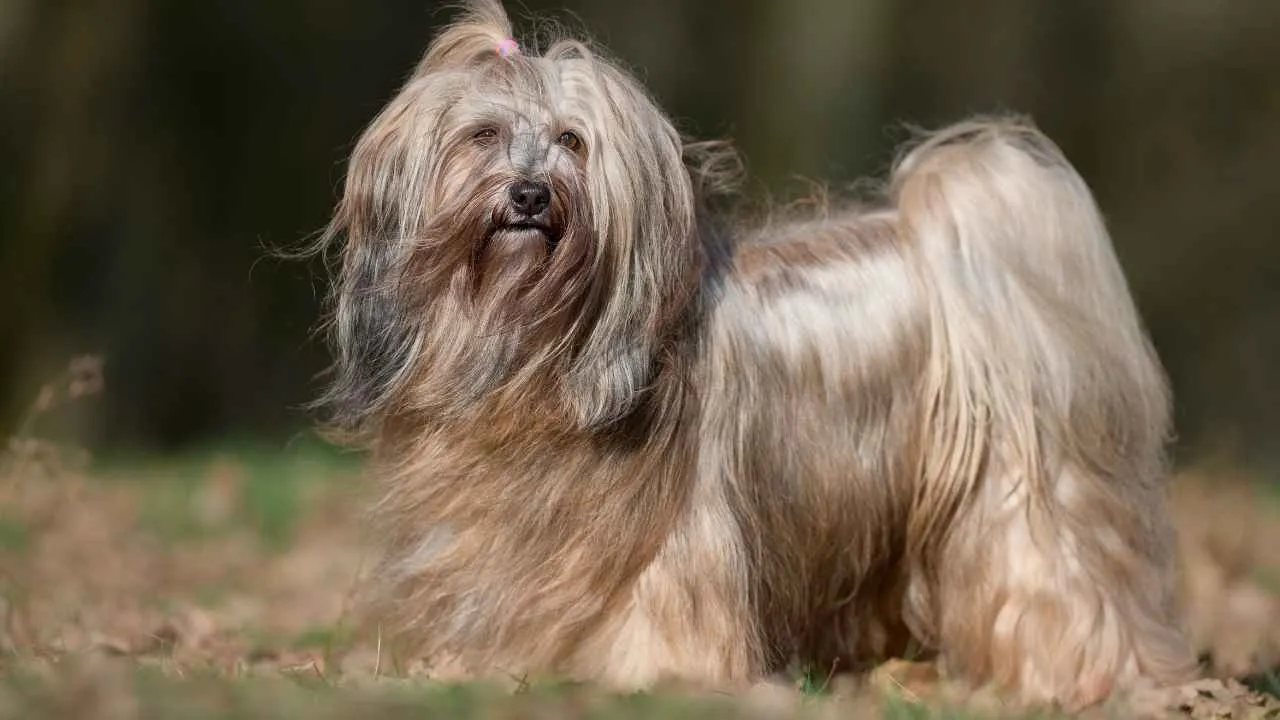
The Tibetan Terrier is an affectionate, medium-sized breed with an impressive, luxurious double coat that is thick, long, and dense. Despite its name, it is not technically a terrier but a herding dog that was originally bred in Tibet to herd sheep and guard monasteries. This breed is also said to bring good luck according to local Tibetan legends.
The Tibetan Terrier’s coat consists of a silky, flowing outer layer and a furry undercoat. Grooming is essential to keep their long fur in good condition. Their undercoat is prone to tangling, and their coat can quickly accumulate dirt, so frequent brushing, at least 2-3 times a week, is required to prevent mats and ensure their coat stays healthy and shiny. Regular bathing also helps maintain their glossy coat.
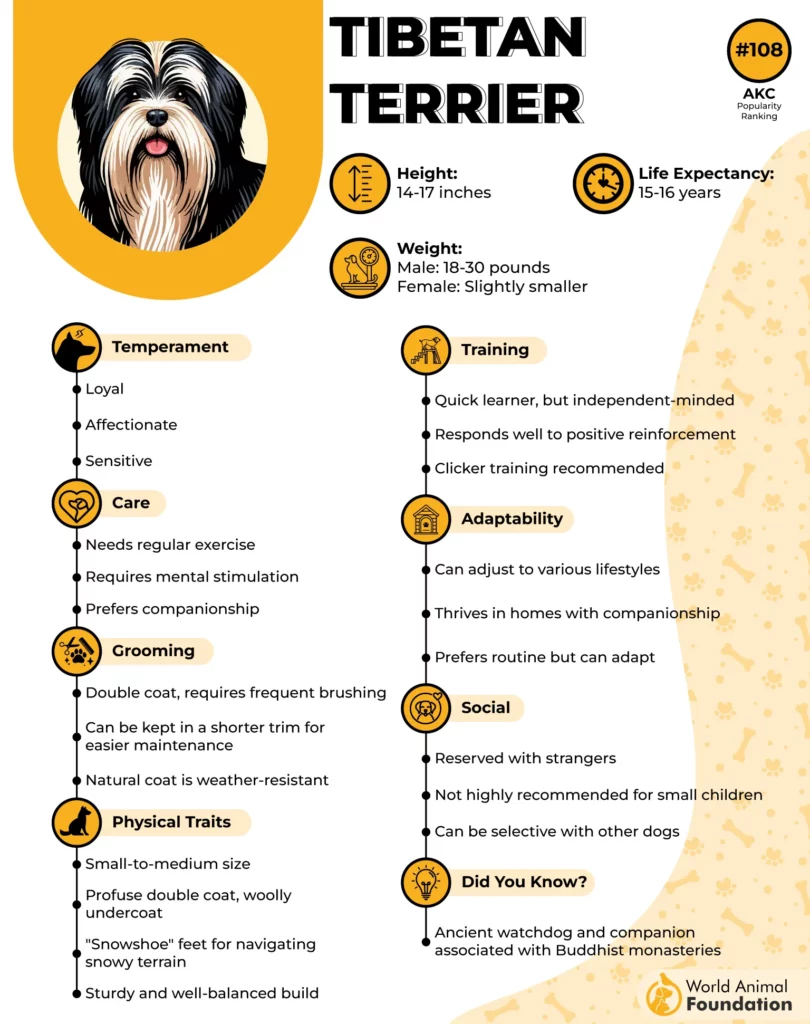
Friendly and alert, Tibetan Terriers make excellent companions. They are affectionate without being overly clingy, and they enjoy spending time with their family. They are typically great with children and other pets, though they may take a little time to warm up to strangers.
Training a Tibetan Terrier is a fulfilling experience. They are intelligent and eager to please, especially when training is consistent and engaging. Their playful yet calm demeanor makes them excellent companions for both individuals and families alike.
6. Komondor
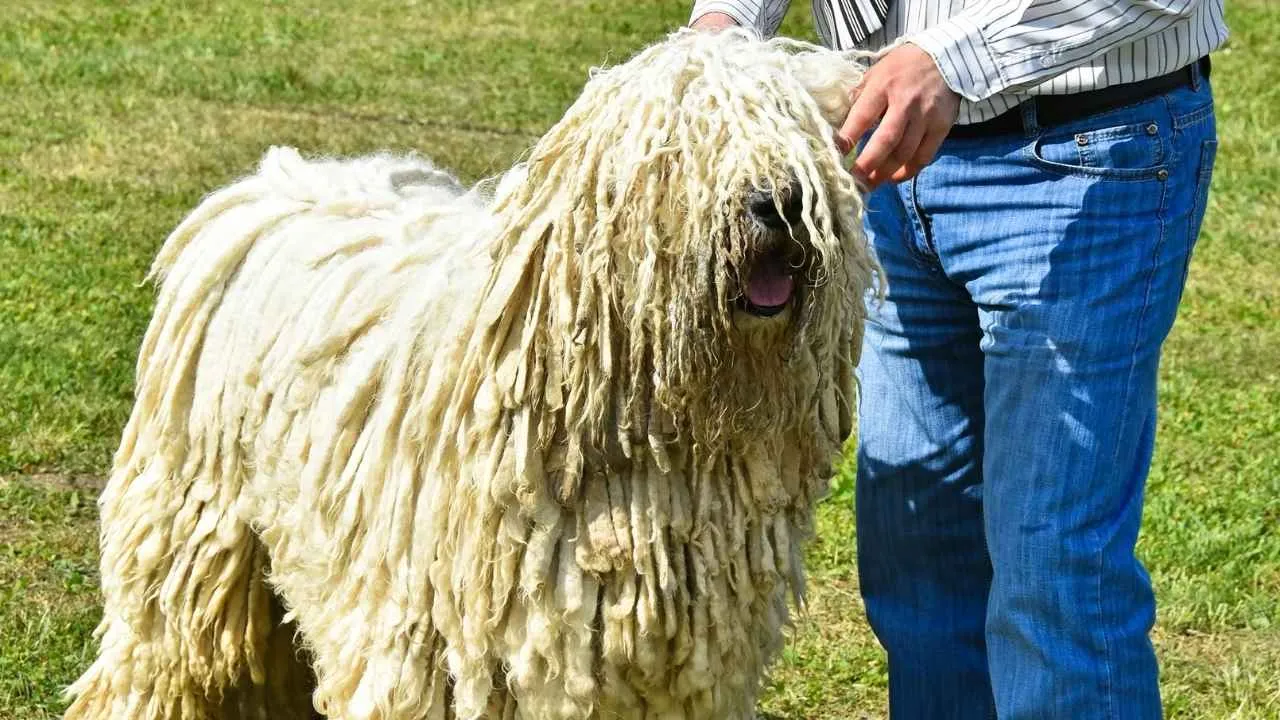
The Komondor is an incredibly unique and striking breed, known for its dense, corded coat that resembles a mop on legs. This long-haired breed originated in Hungary, where it was bred to guard livestock, says Britannica. The cords in the Komondor’s coat serve multiple purposes, including protection from harsh weather and camouflage amongst sheep.
The coat of a Komondor requires specialized care and attention. As they mature, their coat naturally forms cords, which begin to develop after about two years. While no brushing is necessary, the cords need careful separation to avoid mats and mildew, which means they need to be cleaned and dried properly to maintain their luxurious fur. Breed specialists advise separating the cords several times a year to ensure the coat remains free from tangles.
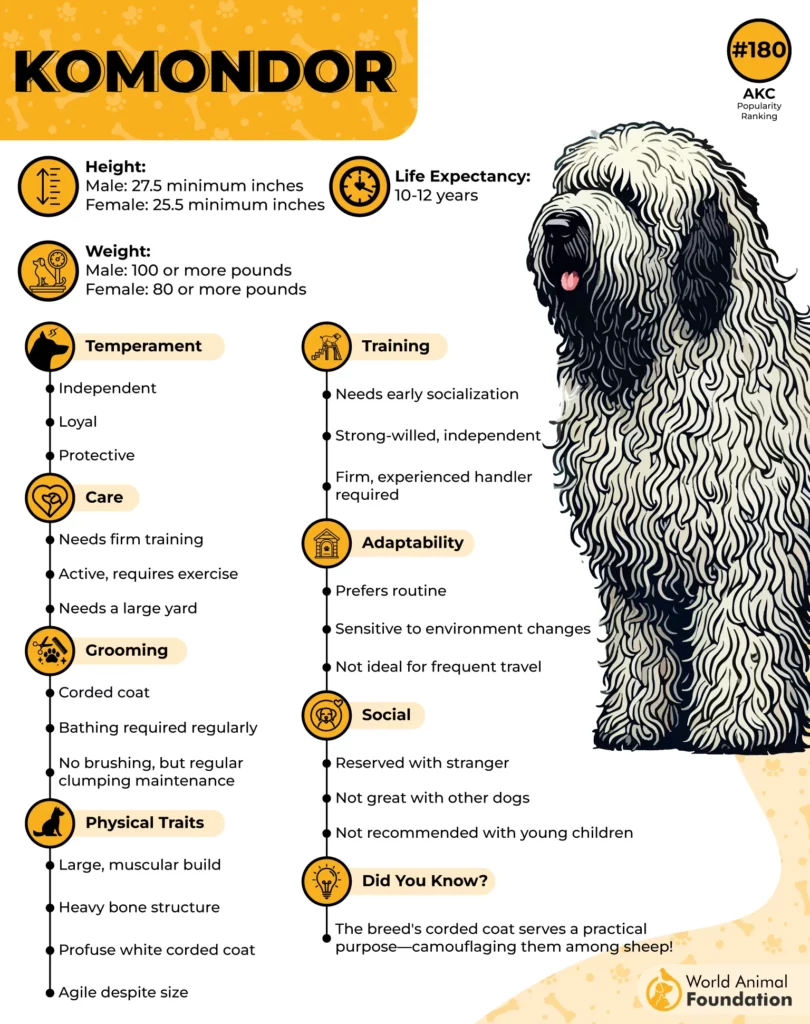
The Komondor is truly an only dog breed in its own right, with its striking corded coat and protective instincts making it a unique and devoted companion. Known as guardians, they are not suited for first-time dog owners but thrive with experienced handlers.
Exercise for a Komondor is essential to keep them healthy, requiring regular walks and mental challenges. Puzzle toys and games work wonders for keeping this breed engaged. Their coat needs dedicated grooming and care, so prospective owners should be prepared for a routine that matches their maintenance needs.
7. Puli
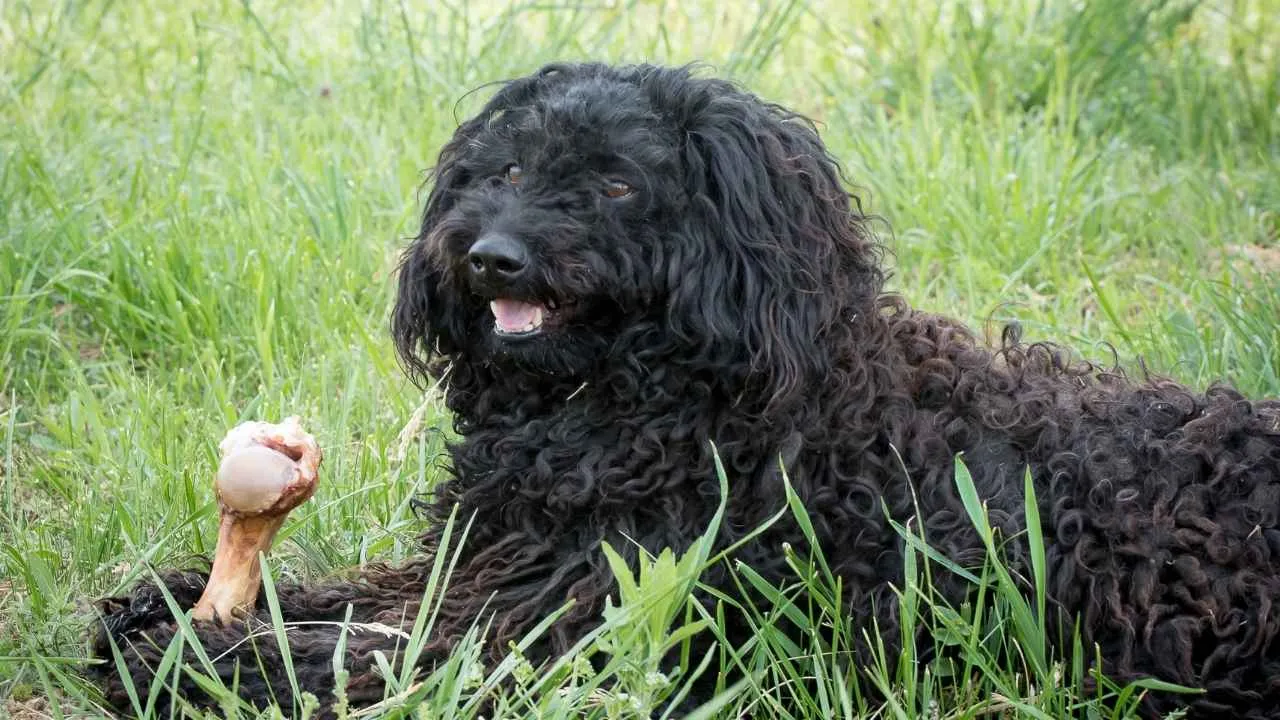
According to PetMD, the Puli is a compact, agile, and energetic herding dog from Hungary that’s well known for its dramatic, corded coat. Unlike the larger and more imposing Komondor, the Puli is smaller in size but equally impressive in appearance. The cords in its coat form naturally around 6 to 12 months of age, and these need to be separated regularly to prevent matting and maintain the dog’s silky fur.
A Puli’s coat is one of its most distinct features, requiring frequent maintenance to stay in good shape. Bathing is a careful process, as it’s important to rinse thoroughly and dry properly to avoid mildew and tangling.
While they shed very little, the grooming process can be time-consuming due to the length and density of their coat. Regular grooming sessions, including weekly brushing and separating of cords, are necessary to maintain their gorgeous coat.
Pulis are highly intelligent, energetic, and thrive when kept busy. They excel at dog sports and agility training, enjoying activities that challenge both their minds and bodies. This breed loves being part of the family and is known for its affectionate and playful nature.
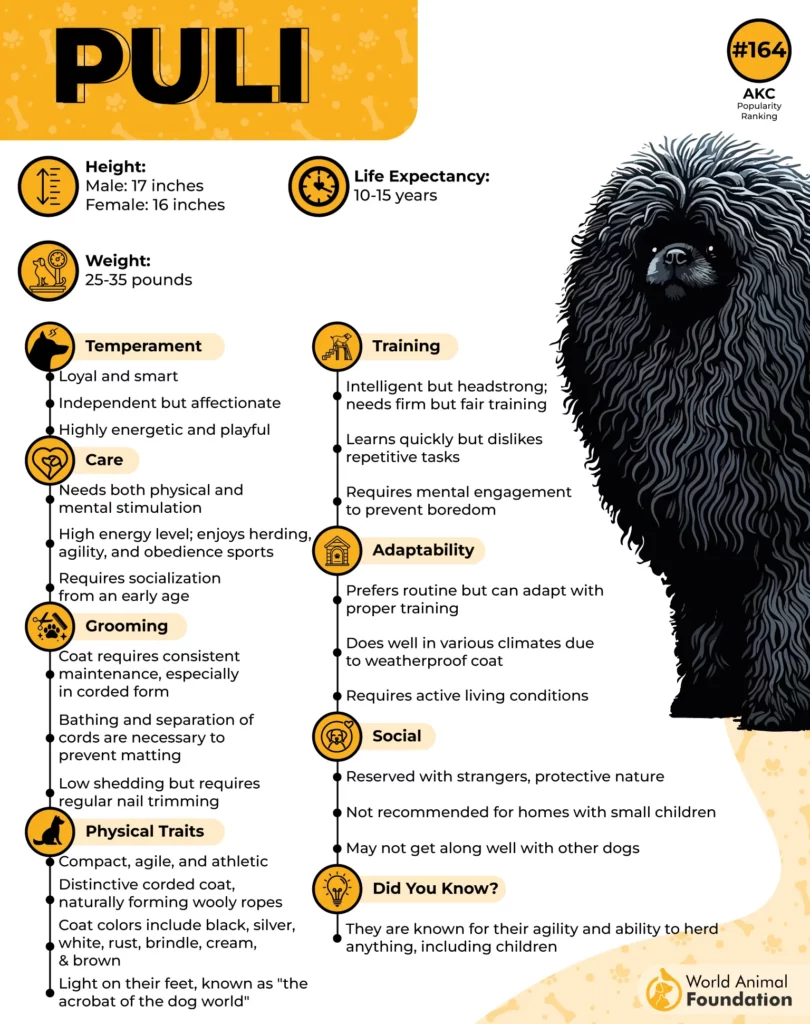
The Puli’s vibrant personality and unique appearance make it a standout breed. Their grooming needs are extensive, but with the right attention, they make wonderful, energetic companions.
8. Yorkshire Terrier
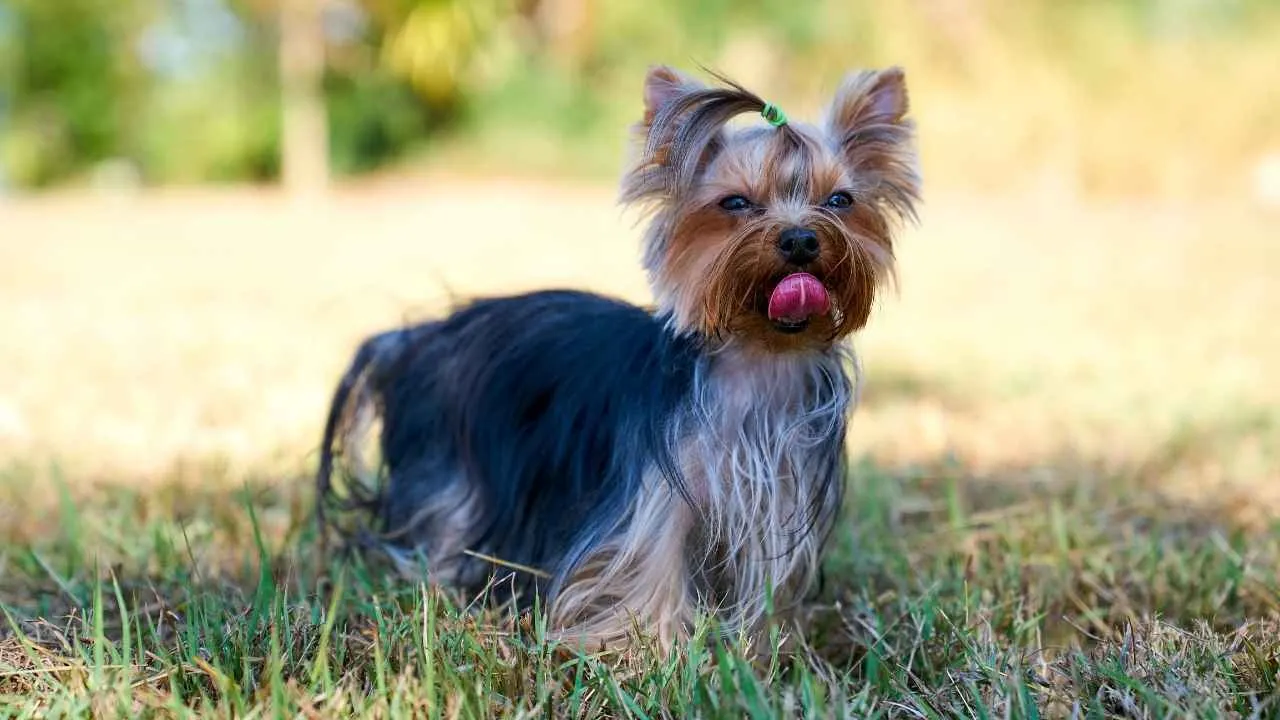
According to the AKC, the Yorkshire Terrier is a tiny yet bold breed with a long coat that flows like human hair. Originally bred for hunting and rat-catching in English mills, today’s Yorkie is often seen as a glamorous companion dog with a distinct coat.
The silky, flowing coat of the Yorkshire Terrier requires regular attention. The coat is fine and shiny, and to keep it tangle-free, daily brushing is highly recommended. Many owners like to tie their Yorkie’s hair into adorable topknots, giving them a classic, polished look. Regular baths and grooming sessions are necessary to maintain their elegant appearance and prevent tangles.
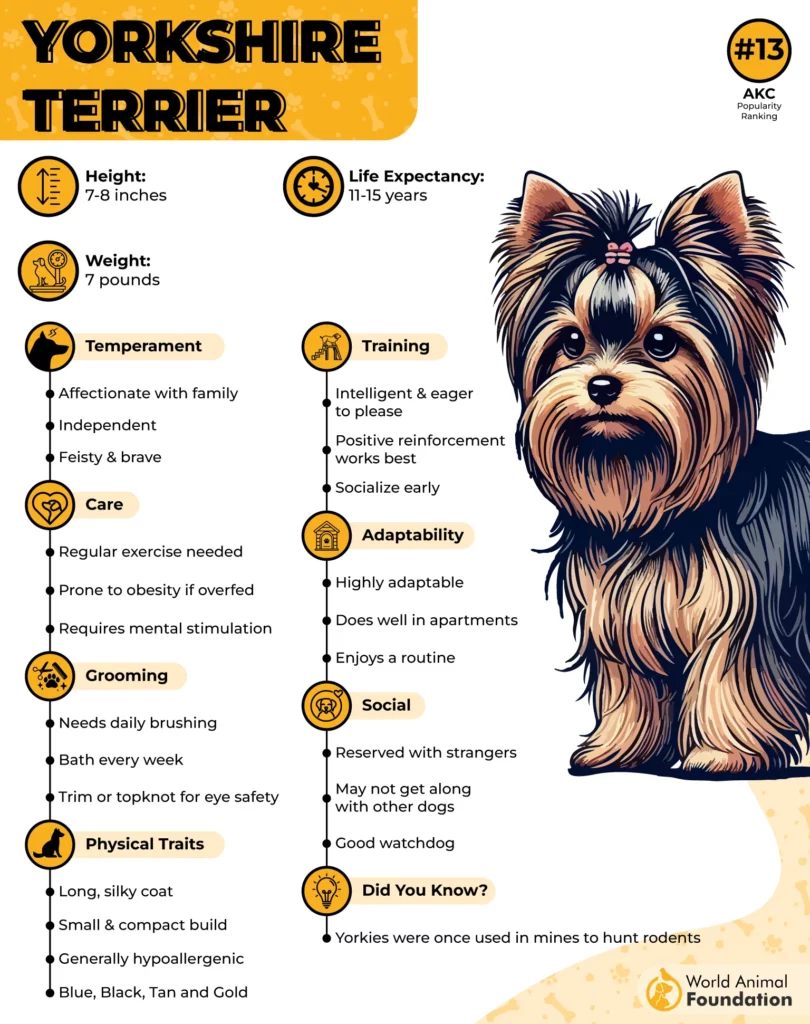
Yorkies are known for their confident and feisty personalities. Despite their small size, they are bold, energetic, and full of spunk. They are highly affectionate, bonding closely with their families and often acting as the center of attention.
Yorkshire Terriers have modest exercise needs, with a couple of short walks and some playtime keeping them content. Their intelligence makes them excellent at learning tricks, and they often excel in obedience training or even competitive dog sports.
9. Polish Lowland Sheepdog
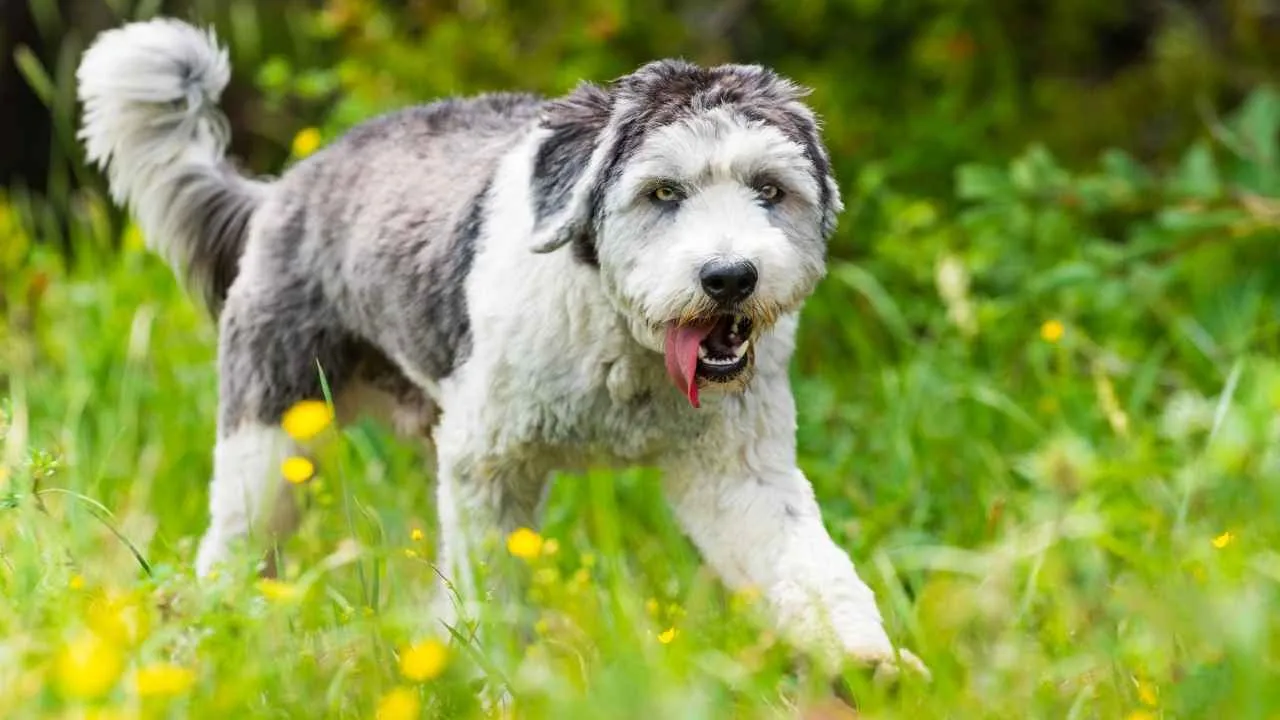
The Polish Lowland Sheepdog, or PON, is a herding dog breed known for its thick, long, shaggy coat, which almost completely covers its eyes. Bred in Poland for herding sheep across various terrains, this breed combines both intelligence and beauty in its appearance and abilities.
The PON’s double coat is dense and requires frequent grooming. Without regular brushing, their silky coat can become matted and tangled, so owners should plan on grooming their PON several times a week to keep the coat healthy. Regular baths are also necessary to maintain their gorgeous fur and prevent their shaggy coat from becoming too cumbersome.
The Polish Lowland Sheepdog is one of the long-haired dog breeds that thrive on training and challenges. They may be a bit stubborn at times, but they respond well to positive reinforcement and enjoy problem-solving. Their intelligence makes them well-suited for families with an active lifestyle, as they need both mental and physical stimulation.
With their family, Polish Lowland Sheepdogs are affectionate, loyal, and often develop strong bonds. They can be reserved with strangers, but they’re not typically aggressive, making them wonderful companions and protective watchdogs.
Conclusion
Extra-long-coat dog breeds are undeniably captivating, offering a combination of elegance and charm that few other dogs can match. Whether it’s the fluffy coat of a Bearded Collie or the unusual coat of the Afghan Hound, these dogs are guaranteed to turn heads. Some dogs, like the Rough-Coated Collie, even have a wavy coat that adds to their distinctive appeal.
However, their magnificent coats require commitment to maintain—frequent brushing and attention to keep their coats healthy and tangle-free, especially if they have a loose undercoat. The rewards, though, are well worth the effort, as these breeds often make excellent family companions with their unique looks and friendly personalities.
When it comes to long-haired dog breeds, some stand out for their silky hair, like the Yorkshire Terrier or the Puli with its distinctive corded coat. Others, such as the Shih Tzu, feature a cotton-like coat that requires care to avoid tangles. While their grooming needs may seem daunting at first, the bond that forms between you and your gorgeous-coated dog is priceless. From the soft and furry undercoat to the thick coat, owning a long-haired breed is a rewarding experience for those ready to put in the care needed to preserve their pet’s stunning appearance. Even breeds with curly coats or short coats offer unique traits that enhance their charm, making them lovable companions.


